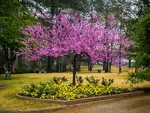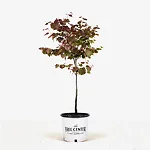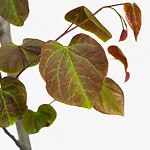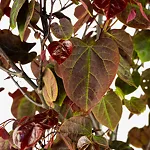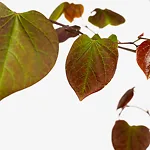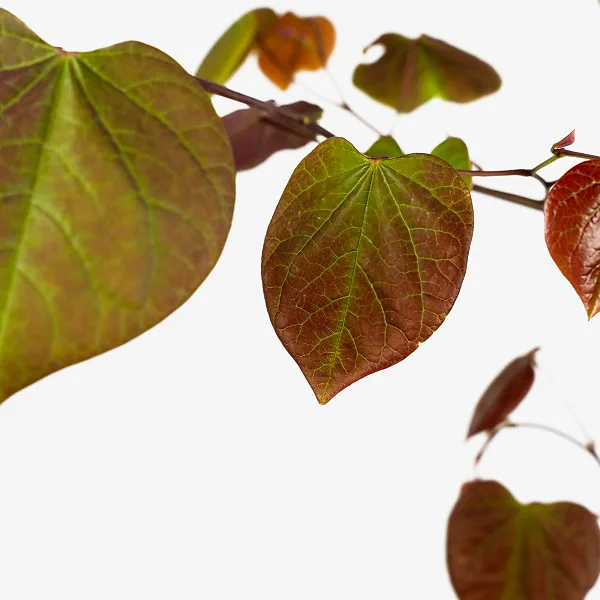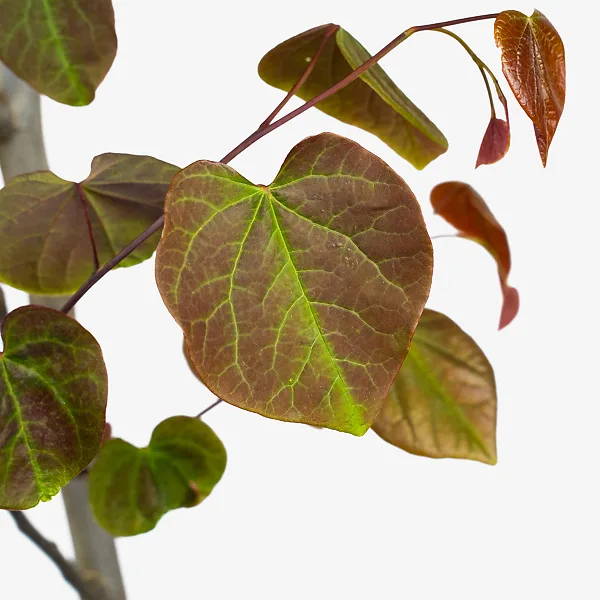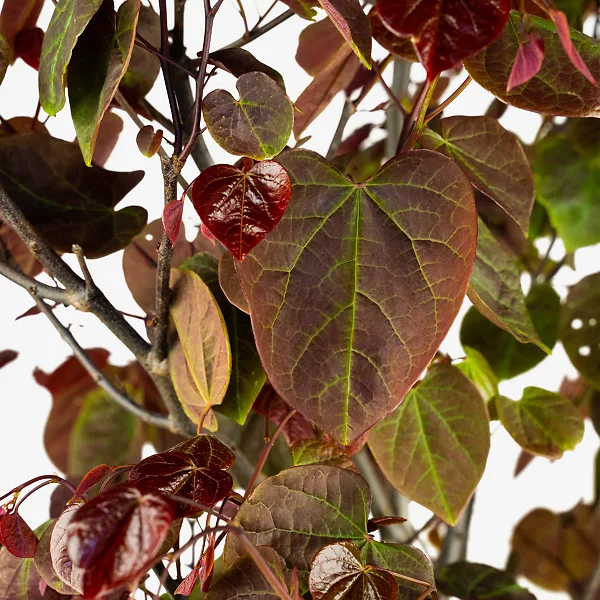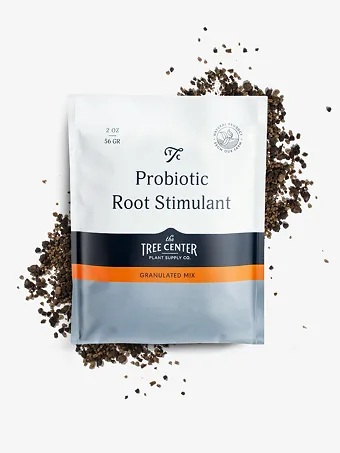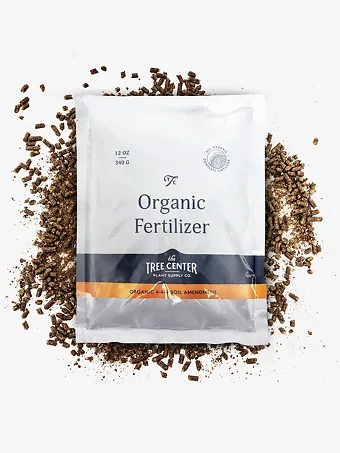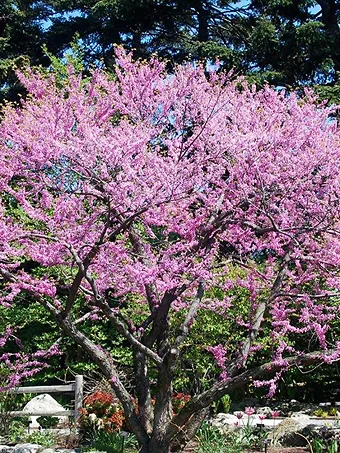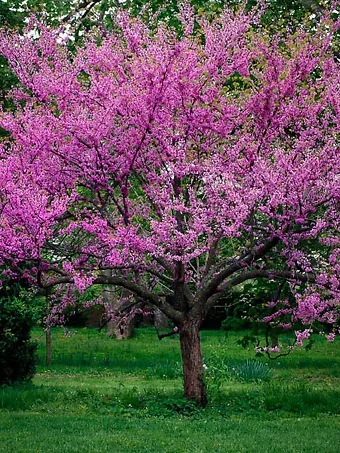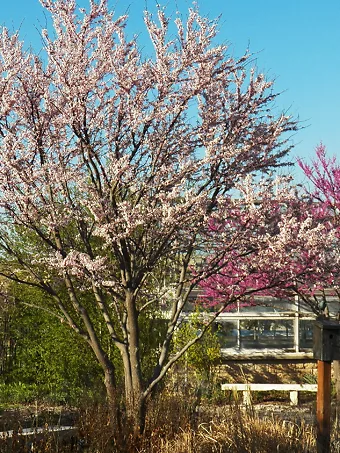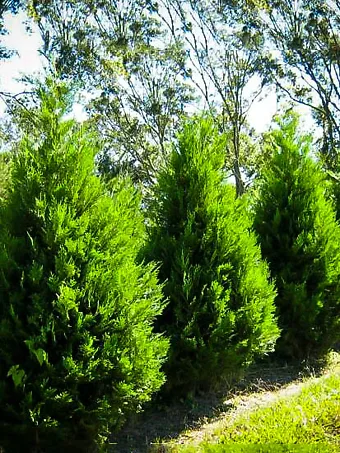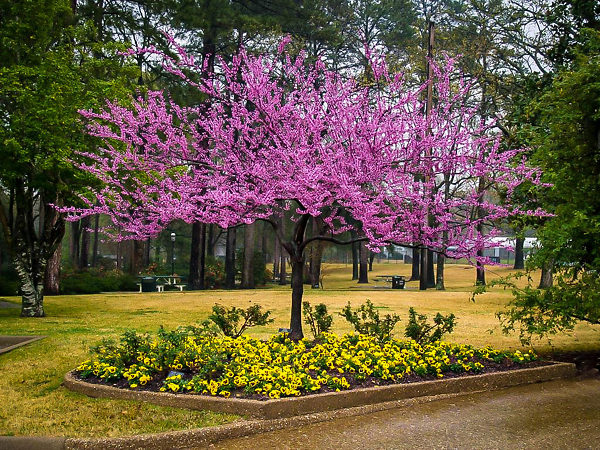
Forest Pansy Redbud
Cercis canadensis 'Forest Pansy'View more from Redbud Trees
Forest Pansy Redbud
Cercis canadensis 'Forest Pansy'
Select Size
30 day - ARRIVE AND THRIVE™ guaranteeLearn more


Special Features

Botanical Name
Cercis canadensis 'Forest Pansy'
Outdoor Growing zone
5-9
Mature Height
20-30
Mature Width
15-20
Sun needs
Full Sun, Partial Sun
The Forest Pansy Redbud is a spectacular small tree with beautiful colored foliage from spring to fall. The new leaves are purple-red, turning deep purple in summer. In fall they turn red, purple, orange and gold. This tree is a beautiful way to add constant color to your garden, contrasting beautifully with the green leaves of other plants around it. In very early spring the bare branches are covered in beautiful flowers of lilac-pink, making a gorgeous display while the rest of your garden is still sleeping. This beautiful tree is derived from an American native tree, so it is perfect for your natural garden, or for growing in woodlands. It also makes a wonderful lawn specimen that is small enough to be used even in a small garden.
- Spectacular purple-red foliage on a small tree
- Lilac-pink flowers in very early spring
- Powerful fall colors of red, orange, purple and gold
- A selected form of an easy to grow American native tree
- Deer resistant and trouble-free
The Forest Pansy Redbud grows best in full sun, and it will also grow in partial shade. It should be planted in rich, moist, well-drained soil, and not left without water in long dry periods. Mulch each spring with some rich compost to ensure vigorous growth. Deer generally ignore this tree, and it is usually pest free too. It also grows near the black walnut, where other trees often fail. It needs no special pruning, and with almost no care it will reward you with season after season of beauty.
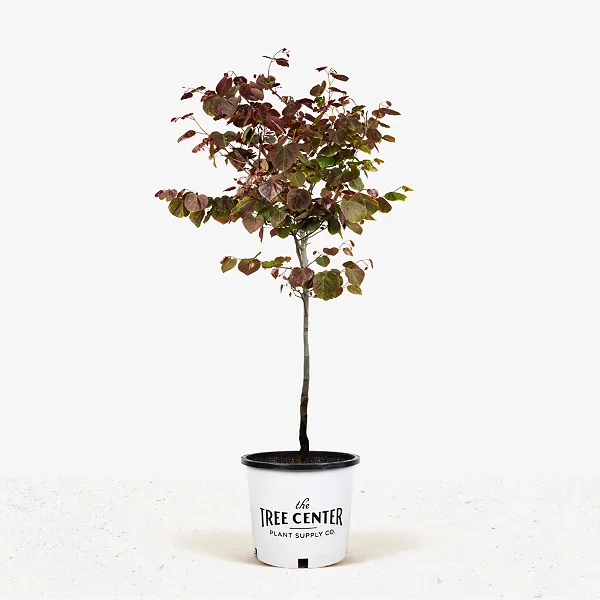
Buy Forest Pansy Redbud Online
The Forest Pansy Redbud is a remarkable small tree that delivers beauty to your garden three times in every year. It begins in very early spring, when the bare, dark branches are suddenly covered in clusters of lilac-pink flowers, turning it into a beacon announcing that spring is on the way. Other trees may still be bare and sleeping, but this tree is going to wake them up. The second surprise comes after the flowers fall.
The new leaves, large, and heart-shaped, emerge not green, but in vibrant, shimmering purple-red. As the summer arrives the leaves darken to deep purple. Then in fall comes the finale. While common redbud leaves turn plain yellow, the Forest Pansy Redbud they turn gorgeous shades of gold, orange, red and purple, ending the season with a bang. Even in winter the picturesque twisted branches of deep gray make a lovely silhouette.
History and Origins
The Forest Pansy Redbud is a selected form of the Eastern Redbud (Cercis canadensis). Although this tree has ‘Canada’ in its name, it in fact only grows naturally in the most southern part of Ontario, near Niagara. It is much more common as a native tree in the USA, all the way down the east from the Great Lakes into Florida, as well as west as far as eastern Texas and Nebraska.
This special form, called ‘Forest Pansy’, cannot be grown from seed, as the seeds will just produce plants with green leaves. Instead, our growers take stem pieces of the tree and attach them to the roots of seedling redbud trees. These develop into a single plant, which thrives and soon becomes a full-sized small tree. If you see branches developing from the base with plain green leaves, cut them off flush with the ground. If necessary, dig down carefully and cut these stems flush with the roots.
The Forest Pansy Redbud has stolen the heart of everyone who has seen it, and it is difficult to keep up with the enormous demand for this tree. We recommend you order now, while we still have stock available – it’s going fast.
Growing Forest Pansy Redbud Trees
The Forest Pansy Redbud grows into a small tree, that in time will reach 20 or 30 feet in height and perhaps 20 feet across. It naturally forms a multi-stem tree, but with training it can be developed with a single trunk instead. Make sure that you allow enough room for its ultimate height and spread when planting. The leaves are 3 to 5 inches across, and heart-shaped. In spring they are purple-red, and in summer that color changes to a deeper purple, but the veins beneath the leaves remain deep red. In hot climates the leaves may become more greenish by the end of summer. In fall they turn red, orange, purple and gold.
Appearance and Flowering
The Forest Pansy Redbud is one of the earliest trees to flower in the garden. While other trees are still completely dormant, many clusters of 4 to 8 flowers develop right on the stems and even on the main branches. These completely cover the tree in a glow of beautiful lilac-pink, which stands out right across even a large garden. The flowering of this form is not quiet as prolific as on the wild tree, but the bonus of those fantastic purple-red leaves more than compensates for that. Plant an Appalachian Redbud as well, which has spectacular flowers in fuchsia-red, and is very profuse in its blooming.
As they fade the flowers develop into bean-like seed pods, between 2 and 4 inches long. These are greenish to begin, and then they turn dark brown in summer. They often remain on the tree as an attractive winter feature.
Uses on Your Property
The Forest Pansy Redbud can be used in so many ways in your garden. Plant it on a lawn as a beautiful small specimen tree. Its smaller size makes it ideal for today’s smaller gardens, and its constant changes will make it always interesting. Grow in behind smaller shrubs in beds or borders, where the beautiful foliage will bring permanent color against the changing blooms of the plants around it. As this is a selected form of a native tree, it grows well in natural settings too, below larger deciduous trees for example, or in a woodland garden. Wherever you grow this beautiful tree you will love it.
Planting and Initial Care
You might think, with all this beauty, that the Forest Pansy Redbud was hard to grow, but not at all. It is fast-growing, and it will grow in full sun or partial shade. Some afternoon shade is beneficial in very hot regions, but too much shade will cause the color of the foliage to fade to greenish shades more quickly. It will grow in most soils, including alkaline ones, as long as they are well-drained and not too dry. Regular moisture is important, so do not leave your tree without water during dry periods, at least until it is mature. If you live in a drier state, where long dry periods are normal, consider growing the drought-resistant Eastern Redbud, which is very similar, but with regular green leaves.
Maintenance
Not only is the Forest Pansy Redbud easy to grow in many kinds of soil, but it is rarely bothered by pests. Even deer usually leave it alone. It will also grow in ground beneath or near the black walnut tree, a tree that is well-known for inhibiting the growth and even killing many plants near it. No pruning is required either, so there is very little to do. If you should see any small dead branches, remove them promptly, at any time of year. If you want a more upright tree form, remove lower branches from the trunks while they are still small, as the tree develops.
